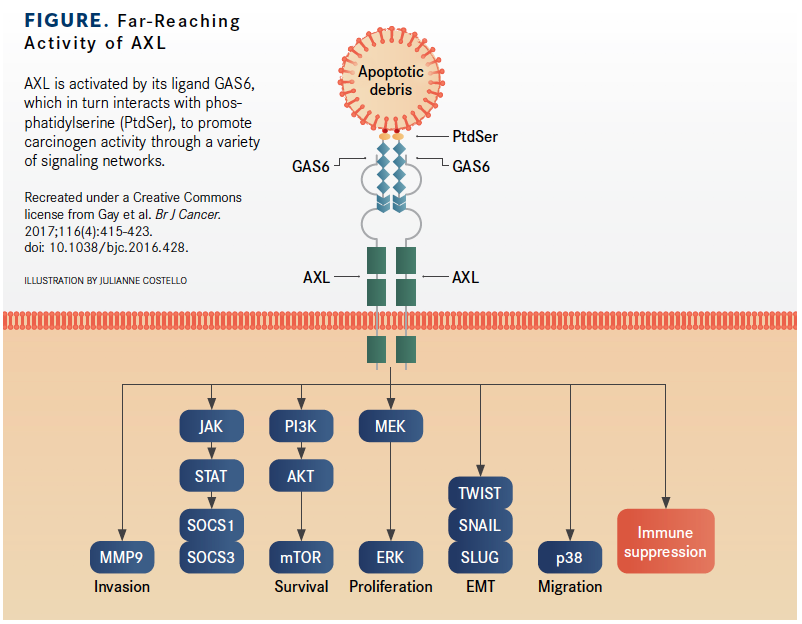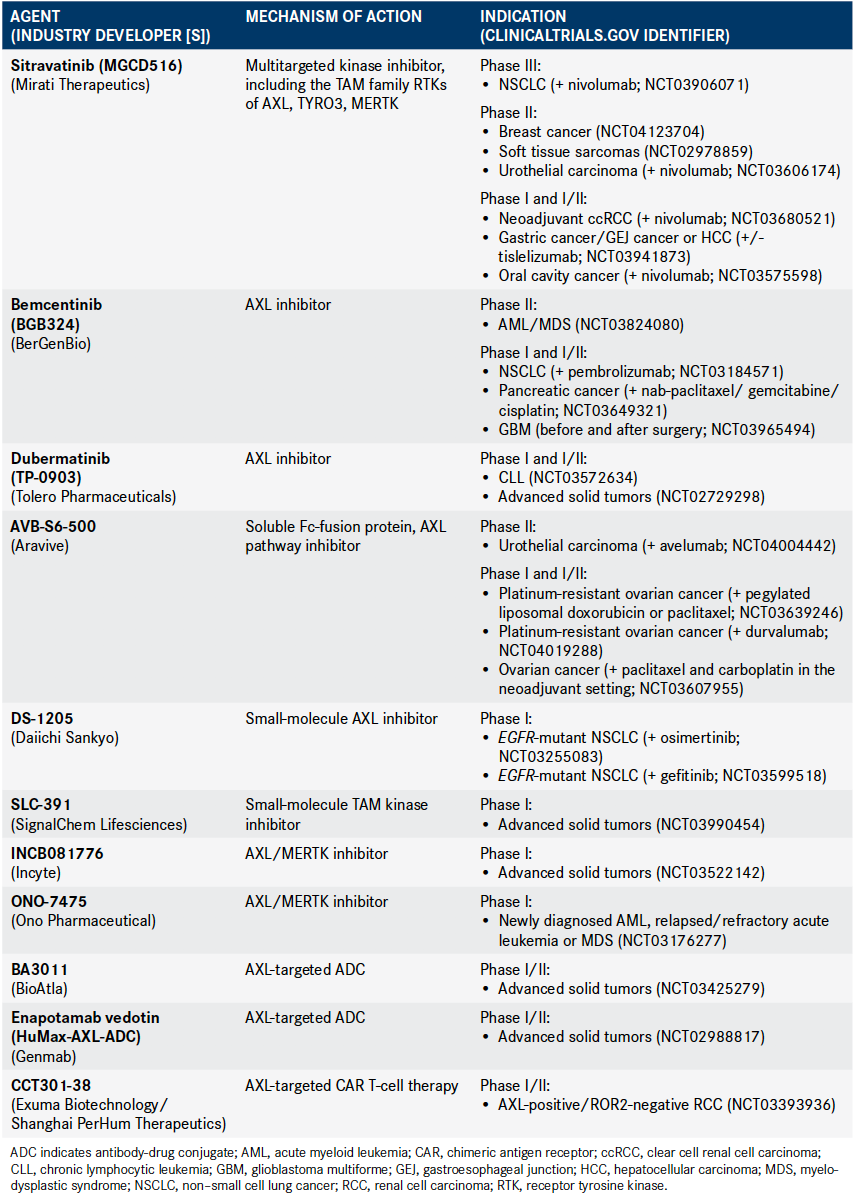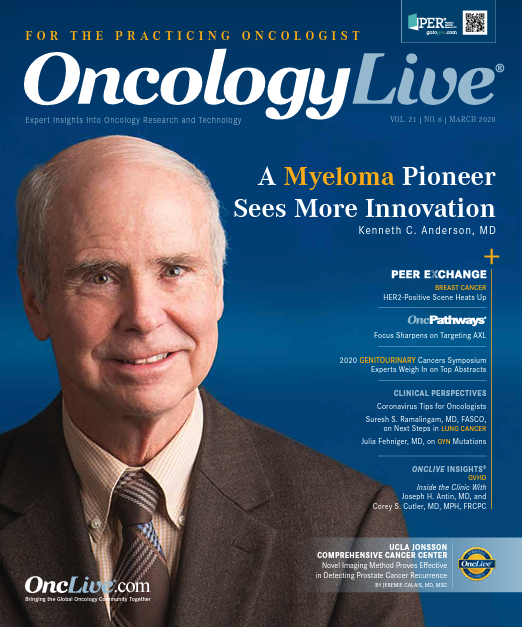Publication
Article
Oncology Live®
AXL Kinase Becomes a Therapeutic Target in Its Own Right
Author(s):
Despite being implicated across the spectrum of cancer hallmarks, aberrant AXL signaling is just starting to emerge as a distinct anticancer target, with a growing focus on specific inhibitors as well as alternative novel drug designs.
Despite being implicated across the spectrum of cancer hallmarks, aberrant AXL signaling is just starting to emerge as a distinct anticancer target, with a growing focus on specific inhibitors as well as alternative novel drug designs.
Although the FDA has approved several multikinase inhibitors that include AXL among their targets, most were not developed to act primarily on this protein; however, studies suggest that some of their functions may be related to AXL inhibition.1,2
During the past 18 months, findings about AXL’s role in immune evasion and its preclinical synergy with immune checkpoint inhibitors (ICIs) are generating excitement over the potential for combination therapy.3-5
Click to Enlarge

A Unique Receptor Family
Alterations in kinase genes are among the most common oncogenic events in cancer and thus present logical drug targets; approximately a quarter of ongoing drug development efforts involve kinase inhibitors.8
The AXL receptor tyrosine kinase (RTK) is unique in that AXL gene alterations are rare, but AXL expression is upregulated on the cell surface in many cancer types, suggesting an advantage for cancer cells. Study findings revealed multifaceted roles for AXL upregulation in cancer, making it an exciting, if somewhat unconventional, target.1,2,9,10
AXL is part of the TAM family of RTKs; the 2 other family members that complete the acronym are TYRO3 and MERTK. The TAM proteins share a unique sequence in their intracellular kinase domain that is essential for tyrosine kinase activity, as well as a unique configuration of immunoglobulin- like and fibronectin type III domains within their extracellular domain.1,2,9,10
TAM family proteins are partially activated by several different ligands, with AXL predominantly activated by the vitamin K—dependent growth arrest–specific 6 (GAS6) protein. Although GAS6 binds to all TAM family members, it has the highest affinity for AXL. Other ligands for AXL have been identified, including Tubby-like protein 1 (TULP1).1,2,9,10
Another unique feature of TAMs is that their maximal activation requires the ligand to bind the cell-membrane lipid phosphatidylserine in addition to the receptor, forming a lipid-protein complex. As with other RTKs, ligand binding triggers AXL dimerization, which brings the receptors in sufficient proximity to phosphorylate one another.1,2,9,10
Phosphorylation causes a change in the shape of the kinase, which allows the intracellular domain to serve as a binding platform for adaptor molecules and downstream effectors that activate downstream signaling pathways. In the case of AXL, these pathways include a preponderance of proproliferation and prosurvival signals, such as the PI3K/AKT/mTOR, MAPK, and JAK/STAT pathways, among others.1,2,9,10 (Figure9)
AXL is widely expressed in healthy tissues, where it plays a variety of roles, including clearing apoptotic material, regulating cell survival, maintaining vascular integrity, and hematopoiesis. AXL and other TAM family members also play an important role in maintaining immune homeostasis by suppressing innate immune-mediated inflammatory responses and natural killer cell activation.1,2,9,10
Many Avenues to Cancer
AXL has long been linked to cancer; it was first identified in a screen for transforming genes in patients with an aggressive form of chronic myeloid leukemia in 1988.11 It turns out, however, that AXL is not a traditional oncogenic driver. Mutations, gene fusions, and amplifications involving the AXL gene are all very rare; nonetheless, AXL protein expression is often highly upregulated on tumor cells, a phenomenon that has been observed across many different types of cancer and is often associated with poorer outcomes.2,9,10,12
The mechanisms underlying AXL overexpression in the absence of genetic alterations are not yet fully understood but likely vary according to the type of tumor. These mechanisms may function at the protein level (posttranslational modifications) or at the mRNA level, increasing the volume of AXL transcripts via epigenetic modifications, such as hypomethylation of the AXL promoter; feedback signaling from other RTKs; or activation of AXL transcription by transcription factors such as hypoxia-inducible factor 1-α (HIF1A), which is upregulated in the hypoxic tumor microenvironment.1,2
It is clear that high levels of AXL expression affect numerous processes in cancer cells, including cell proliferation, cell survival, migration, invasion, epithelial- to-mesenchymal transition, angiogenesis, and stem cell maintenance.1,2,12
Given its role in innate immunity, it is unsurprising that AXL expression appears to have an immunosuppressive role in cancer. AXL signaling can employ several different mechanisms to dampen the antitumor immune response and help cancer cells avoid host immune surveillance.1,2,9,12 A role for AXL in resistance to ICI therapy has also been described.13
In fact, AXL is thought to mediate resistance to diverse forms of cancer therapy, from chemotherapy to radiation therapy to myriad targeted therapies, including inhibitors of VEGF receptors (VEGFR) and other proteins involved in angiogenesis, as well as EGFR, ALK, PI3K, and BRAF/MEK inhibitors.9,10,12,13
Multitargeted Inhibitors
Table. Novel AXL-Targeting Drugs in Development (Click to Enlarge)

These nonselective kinase inhibitors include crizotinib (Xalkori), which was originally designed as an inhibitor of MET but was subsequently found to have potent activity against the ALK and ROS1 kinases. Crizotinib has found its niche in the treatment of non—small cell lung cancer (NSCLC) driven by alterations of these genes.2,18,19
Bosutinib (Bosulif) is an inhibitor of the SRC and ABL kinases and is approved for use in patients with chronic myeloid leukemia caused by fusion of the ABL and BCR genes. Like crizotinib, bosutinib also inhibits AXL than its primary targets.2,11
Cabozantinib (Cabometyx) was developed as a multitargeted antiangiogenic tyrosine kinase inhibitor (TKI) and blocks the activity of MET, VEGFR2, KIT, ROS1, and RET, as well as AXL. It is FDA approved for the treatment of advanced renal cell carcinoma and metastatic medullary thyroid cancer.2,20,21 Other multitargeted kinase inhibitors with AXL among their targets include sunitinib, foretinib, merestinib, and glesatinib.1,2
Clinical trials are ongoing for these drugs, but the primary focus is on their other targets. In a few cases, however, preclinical studies have suggested a link between their ability to inhibit AXL and their antitumor effects.1
Sitravatinib, a newer multitargeted TKI, is described as spectrum selective because it selectively targets closely related kinases, including all the TAM family kinases. It recently showed promise in a phase II trial in combination with the PD-1—targeted monoclonal antibody nivolumab (Opdivo) in patients with metastatic urothelial carcinoma following progression on prior ICI therapy.2,21
Another notable newer drug is gilteritinib (Xospata), a potent dual inhibitor of FLT3 and AXL. FLT3, an RTK involved in hematopoiesis, is one of the most frequently mutated genes in AML.22,23 Gilteritinib was recently approved by the FDA for the treatment of patients with relapsed or refractory FLT3-mutated AML.24 The logic behind combined inhibition of FLT3 and AXL is that AXL overexpression has been shown to drive resistance to FLT3 inhibitors.25
Leveraging AXL
More recently, there has been growing interest in selectively targeting AXL. The first AXL-specific TKI to enter clinical testing was bemcentinib.2 AXL inhibition has been shown to block the constitutive activation of FLT3 caused by internal tandem duplication, the most common type of FLT3 mutation in AML.22,26 Bemcentinib was explored in AML and myelodysplastic syndrome and demonstrated encouraging activity as monotherapy.27
The results of a phase II, open-label study of bemcentinib (at the recommended phase II dose of 200 mg/day) in combination with low-dose cytarabine (n = 11) or decitabine (n = 15) in patients unfit for chemotherapy (median age, 77 years; range, 50-83 years) were presented at the 2019 American Society of Clinical Oncology Annual Meeting (2019 ASCO). Four of the 9 evaluable patients in the low-dose cytarabine group achieved rapid complete remission with incomplete hematologic recovery, and 2 achieved durable stable disease (SD). In the decitabine group, 4 of the 11 evaluable patients achieved incomplete hematologic recovery, and 1 achieved durable SD.27 Bemcentinib has received fast track designation from the FDA for the treatment of elderly patients with relapsed AML.6
Bemcentinib is also being evaluated in other cancer types, including NSCLC. A recent report showed that it had significant activity in combination with the ICI pembrolizumab (Keytruda) in patients with chemotherapy-refractory, immunotherapynaïve disease. Among 38 evaluable patients at the time of a presentation at the 2019 European Society of Molecular Oncology Congress (2019 ESMO), the overall response rate was 26% and the median overall survival was 12.2 months. A subset of 19 patients with AXL-expressing tumors also had a median overall survival of 12.2 months, and their overall response rate was 38%.28
Tolero Pharmaceuticals is developing dubermatinib (TP-0903), another selective AXL inhibitor. The results of a phase I dose-escalation study in patients with advanced solid tumors were presented at 2019 ESMO. At the time of presentation, 36 patients had been treated with TP-0903 daily for 21 days of each 28-day cycle at 9 dose levels from 1.5 to 37 mg/m2, and 11 patients had achieved SD with a median duration of 3.7 months.29
AVB-S6-500 is a novel, high-affinity, soluble Fc-fusion protein that blocks binding of the GAS6 ligand to its endogenous receptor, AXL. Development is most advanced in patients with platinum-resistant recurrent ovarian cancer. Results from 12 patients enrolled in the phase Ib safety lead-in portion of a study were presented at the 2019 ESMO. Patients were enrolled in 2 cohorts in which 10 mg/kg AVB-S6-500 was combined with either pegylated liposomal doxorubicin or paclitaxel. Both combinations were safe and well tolerated. A partial response (PR) was experienced by 41.7% of patients, and the clinical benefit rate was 58%. Three responders had ≥60% tumor regression, and 2 responders had >80%. The fast track designation for AVB-S6-500 is for platinum-resistant recurrent ovarian cancer.7,30
Enapotamab vedotin is an AXL-targeted ADC in clinical development in which an anti-AXL monoclonal antibody is conjugated to the antimitotic drug monomethyl auristatin E. Results from an ongoing phase I clinical trial in advanced solid tumors were presented at 2019 ASCO. There were 47 patients enrolled at the time of presentation: 8 with NSCLC, 9 with melanoma, 22 with ovarian cancer, 3 with cervical cancer, and 5 with endometrial cancer. Participants received enapotamab vedotin as monotherapy at doses of 0.3 to 2.8 mg/kg once every 3 weeks (n = 32) or 0.45 to 1.4 mg/kg 3 times over 4 weeks (n = 15). The maximum tolerated dose was 2.2 mg/kg and 1.0 mg/kg in the 2 arms, respectively, and 6 patients experienced dose-limiting toxicities: constipation, vomiting, γ-glutamyltransferase increase, febrile neutropenia, and diarrhea. Three patients achieved PRs: 1 with NSCLC and 2 with ovarian cancer.31
Meanwhile, chimeric antigen receptor (CAR) T-cell therapies targeting AXL are also being explored. A first-in-human umbrella trial of 2 CAR T-cell therapies, the AXL-directed CCT301-38 and the ROR2-directed CCT301-59, is being carried out at Shanghai Public Health Clinical Center. These CAR T cells are conditionally active at the acidic pH of the tumor microenvironment in an effort to minimize off-target effects.
Patients with relapsed/refractory metastatic renal cell carcinoma with AXL- or ROR2- positive biopsies are enrolled and treated with the respective therapy. Administered doses range from 1 × 105 to 1 × 107 cells/kg. As of February 2019, 7 subjects had been enrolled; 2 treated with CCT301-38 achieved SD as best response, with one 29.3% tumor reduction at a dose of 1 × 106 cells/kg.32
Jane de Lartigue, PhD, is a freelance medical writer and editor based in Gainesville, Florida.
Undoubtedly, AXL presents a promising therapeutic target, and it has been on the radar for investigators and drug companies for many years. Until recently, however, AXL had only been an inadvertent target of multitargeted kinase inhibitors that were predominantly designed to block other kinases.2,3,14-17
Meanwhile, BerGenBio’s bemcentinib (BGB324), a selective AXL inhibitor, and Aravive’s AVB-S6-500, an Fc-fusion protein that blocks activation of AXL pathway signaling, have received Fast Track designations from the FDA for relapsed acute myeloid leukemia (AML) and platinum-resistant ovarian cancer, respectively, suggesting that first-in-class drug approvals may be on the horizon.6,7 A variety of other novel agents also are in development (Table).
References
- Graham DK, DeRyckere D, Davies KD, Earp HS. The TAM family: phosphatidylserine-sensing receptor tyrosine kinases gone awry in cancer. Nat Rev Cancer. 2014;14(12):769-785. doi: 10.1038/nrc3847.
- Zhu C, Wei Y, Wei X. AXL receptor tyrosine kinase as a promising anti-cancer approach: functions, molecular mechanisms and clinical applications. Mol Cancer. 2019;18(1):153. doi: 10.1186/s12943-019-1090-3.
- Favata M, Lasky K, Lo Y, et al. Characterization of INCB081776, a potent and selective dual AXL/MER kinase inhibitor. Cancer Res. 2018;78(suppl 13; abstr 3759). doi: 10.1158/1538-7445.Am2018-3759.
- Kasikara C, Davra V, Calianese D, et al. Pan-TAM tyrosine kinase inhibitor BMS-777607 enhances anti-PD-1 mAb efficacy in a murine model of triple-negative breast cancer. Cancer Res. 2019;79(10):2669-2683. doi: 10.1158/0008-5472.CAN-18-2614.
- Lai S, Li R, Raha P, et al. Activity of the TAM kinase-targeting compound, SLC-391, is mediated by the engagement of the immune system in CT-26 syngeneic mouse model. Mol Cancer Ther. 2018;17(suppl 1; abstr B148). doi: 10.1158/1535-7163.Targ-17-b148.
- BerGenBio receives FDA approval of fast track designation for bemcentinib. Bergen, Norway: BerGenBio ASA; October 23, 2019. BerGenBio website. bergenbio.com/bergenbio-receives-fda-approval-of-fast-track-designation-for-bemcentinib/. Accessed February 3, 2020.
- US FDA grants fast track designation to AVB-S6-500 for platinum-resistant ovarian cancer. Houston, TX: Aravive Biologics, Inc; August 20, 2018. Aravive website. ir.aravive.com/news-releases/news-release-details/us-fda-grants-fast-track-designation-aravive-biologics-avb-s6. Accessed February 5, 2020.
- Bhullar KS, Lagarón NO, McGowan EM, et al. Kinase-targeted cancer therapies: progress, challenges and future directions. Mol Cancer. 2018;17(1):48. doi: 10.1186/s12943-018-0804-2.
- Gay CM, Balaji K, Byers LA. Giving AXL the axe: targeting AXL in human malignancy. Br J Cancer. 2017;116(4):415-423. doi: 10.1038/bjc.2016.428.
- Shen Y, Chen X, He J, Liao D, Zu X. Axl inhibitors as novel cancer therapeutic agents. Life Sci. 2018;198:99-111. doi: 10.1016/j.lfs.2018.02.033.
- Liu E, Hjelle B, Bishop JM. Transforming genes in chronic myelogenous leukemia. Proc Natl Acad Sci U S A. 1988;85(6):1952-1956. doi: 10.1073/pnas.85.6.1952.
- Wium M, Paccez JD, Zerbini LF. The dual role of TAM receptors in autoimmune diseases and cancer: an overview. Cells. 2018;7(10):e166. doi: 10.3390/cells7100166.
- Aguilera TA, Giaccia AJ. Molecular pathways: oncologic pathways and their role in T-cell exclusion and immune evasion-a new role for the AXL receptor tyrosine kinase. Clin Cancer Res. 2017;23(12):2928-2933. doi: 10.1158/1078-0432.CCR-17-0189.
- Holland SJ, Pan A, Franci C, et al. R428, a selective small molecule inhibitor of axl kinase, blocks tumor spread and prolongs survival in models of metastatic breast cancer. Cancer Res. 2010;70(4):1544-1554. doi: 10.1158/0008-5472.Can-09-2997.
- Jimbo T, Hatanaka M, Komatsu T, et al. DS-1205b, a novel selective inhibitor of AXL kinase, blocks resistance to EGFR-tyrosine kinase inhibitors in a non-small cell lung cancer xenograft model. Oncotarget. 2019;10(50):5152-5167. doi: 10.18632/oncotarget.27114.
- Lai S, Xu Q, Yan J, Zhang H, Zhang Z. AXL inhibitor promotes anti-tumor immunity through modulation of macrophage polarization. Cancer Res. 2018;78(suppl 13; abstr 3853). doi: 10.1158/1538-7445.Am2018-3853.
- Mollard A, Warner SL, Call LT, et al. Design, synthesis and biological evaluation of a series of novel Axl kinase inhibitors. ACS Med Chem Lett. 2011;2(12):907-912. doi: 10.1021/ml200198x.
- Cui JJ, Tran-Dubé M, Shen H, et al. Structure based drug design of crizotinib (PF-02341066), a potent and selective dual inhibitor of mesenchymal—epithelial transition factor (c-MET) kinase and anaplastic lymphoma kinase (ALK). J Med Chem. 2011;54(18):6342-6363. doi: 10.1021/jm2007613.
- Poon CC, Kelly JJ. Development of crizotinib, a rationally designed tyrosine kinase inhibitor for non-small cell lung cancer. Int J Cancer. 2017;140(9):1945-1954. doi: 10.1002/ijc.30533.
- Leavitt J, Copur MS. FDA approved uses of cabozantinib. Oncology (Williston Park). 2019;33(9):685004.
- Mirati Therapeutics presents data from ongoing clinical trials of sitravatinib in combination with nivolumab at the SITC 34th Annual Meeting. San Diego, CA: Mirati Therapeutics, Inc; November 9, 2019. Cision website. prnewswire.com/news-releases/mirati-therapeutics-presents-data-from-ongoing-clinical-trials-of-sitravatinib-in-combination-with-nivolumab-at-the-sitc-34th-annual-meeting-300955157.html. Accessed February 4, 2020.
- DiNardo CD, Stone RM, Medeiros BC. Novel therapeutics in acute myeloid leukemia. Am Soc Clin Oncol Educ Book. 2017;37:495-503. doi: 10.1200/EDBK_175401.
- Heuser M, Mina A, Stein EM, Altman JK. How precision medicine is changing acute myeloid leukemia therapy. Am Soc Clin Oncol Educ Book. 2019;39:411-420. doi: 10.1200/EDBK_238687.
- Zhao J, Song Y, Liu D. Gilteritinib: a novel FLT3 inhibitor for acute myeloid leukemia. Biomark Res. 2019;7:19. doi: 10.1186/s40364-019-0170-2.
- Park IK, Mundy-Bosse B, Whitman SP, et al. Receptor tyrosine kinase Axl is required for resistance of leukemic cells to FLT3-targeted therapy in acute myeloid leukemia. Leukemia. 2015;29(12):2382-2389. doi: 10.1038/leu.2015.147.
- Park IK, Mishra A, Chandler J, Whitman SP, Marcucci G, Caligiuri MA. Inhibition of the receptor tyrosine kinase Axl impedes activation of the FLT3 internal tandem duplication in human acute myeloid leukemia: implications for Axl as a potential therapeutic target. Blood. 2013;121(11):2064-2073. doi: 10.1182/blood-2012-07-444018.
- Loges S, Heuser M, Chromik J, et al. First-in class selective AXL inhibitor bemcentinib (BGB324) in combination with LDAC or decitabine exerts anti-leukaemic activity in AML patients unfit for intensive chemotherapy: phase II open-label study. J Clin Oncol. 2019;37(suppl 15; abstr 7043). doi: 10.1200/JCO.2019.37.15_suppl.7043.
- Trigo Perez JM, Felip E, Brunsvig P, et al. Efficacy results of selective AXL inhibitor bemcentinib with pembrolizumab following chemo in patients with NSCLC. Ann Oncol. 2019;30(suppl 5; abstr 1576P). doi: 10.1093/annonc/mdz260.098.
- Sarantopoulos J, Fotopoulos G, Tsai FYC, et al. A phase Ia/b first-in-human, open-label, dose-escalation, safety, PK and PD study of TP-0903 in solid tumours. Ann Oncol. 2019;30(suppl 5; abstr 460P). doi: 10.1093/annonc/mdz244.022.
- Monk BJ, Coleman RL, Moore KN, et al. Phase Ib/II study of AVB500 (high affinity inhibitor of GAS6/AXL path) in combination with PAC and PLD in platinum resistant recurrent ovarian cancer. Ann Oncol. 2019;30:(suppl 5; abstr LBA59). doi: 10.1093/annonc/mdz394.056.
- Ameratunga M, Harvey RD, Mau-Sørensen M, et al. First-in-human, dose-escalation, phase (ph) I trial to evaluate safety of anti-Axl antibody-drug conjugate (ADC) enapotamab vedotin (EnaV) in solid tumors. J Clin Oncol. 2019;37(suppl 15; abstr 2525). doi: 10.1200/JCO.2019.37.15_suppl.2525.
- Zhu T, Ling Y, Bao J, Cheng X, Hu X, Yang C. A precision medicine-directed umbrella trial design of two first-in-human solid tumor CAR-T products in subjects with recurrent or refractory stage IV mRCC. Paper presented at: Annual Meeting of the Association for Cancer Immunotherapy; May 21-23, 2019; Mainz, Germany.










